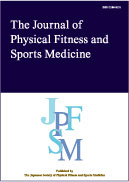Volume 5, Issue 1
Displaying 1-17 of 17 articles from this issue
- |<
- <
- 1
- >
- >|
Editorial Article
-
2016Volume 5Issue 1 Pages 1-3
Published: March 25, 2016
Released on J-STAGE: March 18, 2016
Download PDF (829K) -
2016Volume 5Issue 1 Pages 4
Published: March 25, 2016
Released on J-STAGE: March 18, 2016
Download PDF (805K) -
2016Volume 5Issue 1 Pages 5
Published: March 25, 2016
Released on J-STAGE: March 18, 2016
Download PDF (794K)
Review Article
-
2016Volume 5Issue 1 Pages 7-12
Published: March 25, 2016
Released on J-STAGE: March 18, 2016
Download PDF (1062K) -
2016Volume 5Issue 1 Pages 13-23
Published: March 25, 2016
Released on J-STAGE: March 18, 2016
Download PDF (1956K) -
2016Volume 5Issue 1 Pages 25-36
Published: March 25, 2016
Released on J-STAGE: March 18, 2016
Download PDF (1300K) -
2016Volume 5Issue 1 Pages 37-46
Published: March 25, 2016
Released on J-STAGE: March 18, 2016
Download PDF (1475K) -
2016Volume 5Issue 1 Pages 47-55
Published: March 25, 2015
Released on J-STAGE: March 18, 2016
Download PDF (3537K) -
2016Volume 5Issue 1 Pages 57-67
Published: March 25, 2016
Released on J-STAGE: March 18, 2016
Download PDF (1100K)
Short Review Article
-
2016Volume 5Issue 1 Pages 69-72
Published: March 25, 2016
Released on J-STAGE: March 18, 2016
Download PDF (951K) -
2016Volume 5Issue 1 Pages 73-76
Published: March 25, 2016
Released on J-STAGE: March 18, 2016
Download PDF (899K) -
2016Volume 5Issue 1 Pages 77-80
Published: March 25, 2016
Released on J-STAGE: March 18, 2016
Download PDF (939K) -
2016Volume 5Issue 1 Pages 81-86
Published: March 25, 2016
Released on J-STAGE: March 18, 2016
Download PDF (2463K)
Regular Article
-
2016Volume 5Issue 1 Pages 87-94
Published: March 25, 2016
Released on J-STAGE: March 18, 2016
Download PDF (1164K) -
2016Volume 5Issue 1 Pages 95-103
Published: March 25, 2016
Released on J-STAGE: March 18, 2016
Download PDF (1243K) -
2016Volume 5Issue 1 Pages 105-113
Published: March 25, 2016
Released on J-STAGE: March 18, 2016
Download PDF (1239K)
Correction
-
2016Volume 5Issue 1 Pages 115
Published: March 25, 2016
Released on J-STAGE: March 18, 2016
Download PDF (1181K)
- |<
- <
- 1
- >
- >|
